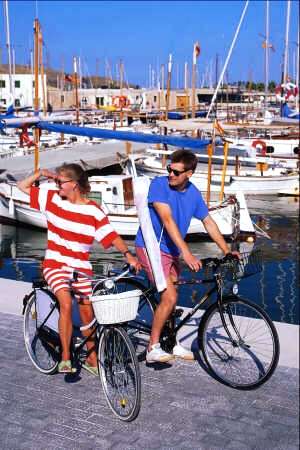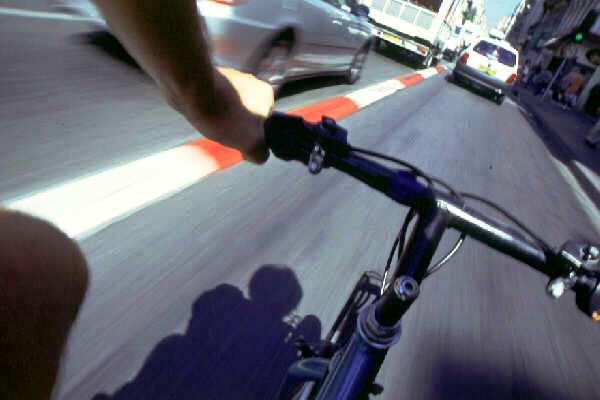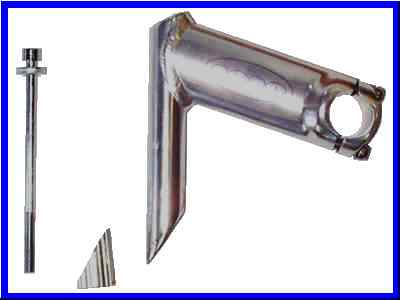Save Big With Bicycle Discount Coupon Codes
So, You've Got a New Bike!

Understanding your Bicycle
Bicycles are not like the other machines in your life. Bicycles are not as reliable as some other machines. But then, those in your house can weight 300 pounds. It's nearly impossible to ride a one of them up a hill. The bicycle has to be a compromise between weight, cost and reliability. Even if you spent thousands of dollars on your bike, it will still not be as reliable as your household appliances. So, the bike will need some adjustment from time to time. It may even break down. But you can learn to appreciate even that, if you keep in mind that a human on a bicycle is the most efficient machine on earth in terms of energy expended for mass moved. A human on a bicycle is also the most efficient lifeform on earth, in terms of distance traveled for energy expended.
The Most Important Thing
The most important thing to know when you get a new bike is to ride it for short distances at first. There are two reasons. The first is that the bike may fail in some way, and you'll have to walk home. Yes, it happens with new bikes sometimes. The other reason is that unless you have been riding another bike recently, your body is not yet used to riding. It is extremely easy to ride too far, then have to ride home when you are already tired or sore. Everyone makes that mistake! On your first day, it's better to ride just one mile - really, just one mile! Tomorrow, you can ride two miles. Perhaps you can work up to five mile rides in a week or two. But guess what? In a year you can ride 100 miles or more in a day, if you want to. I have seen bicycles bring about remarkable changes in people. Just the other day, a teenager came back for some warranty work on his bicycle. I didn't recognize him. He weighed 30 pounds less. He explained that for the first time in his life, he found something to do that was more fun than watching TV, and certainly better for his health. He had gone from downright pudgy to absolutely healthy. I have seen the same effect in 70-year-olds. As one ages, it is even more dramatic. You see, as we age, we tend to become more sedentary. It's not just about TV. We seem to enjoy chess more than tennis, we have jobs where we fill out paperwork rather than doing the manual labor we did when we were younger. So riding you bike can literally extend your life in a natural, enjoyable way. For many, the enjoyment of getting out and around the neighborhood, or into the woods makes the exercise secondary. We're going for the ride, not the exercise. I like that. I'd rather get exercise doing something I enjoy, than trying to figure out how to enjoy getting exercise.
The Down Side
There are two issues about bicycling that should be considered. One is the danger. It is dangerous if you don't know what you're doing. Basically, it boils down to remembering the danger, and acting accordingly. Stay alert or don't ride. Be visible, especially at night with lights and reflectors. Follow the rules of the road. If you do things motorists don't expect, they may not know how to react, or they may not even see you at all. Think about the motorist making a right-hand turn. If you're on the wrong side of the road, that motorist will never see you ,since he only looks to the left before turning. You'll find some interesting discussion of safety here.

Urban bicycling goes a long way to saving gasoline and reducing pollution and noise. For every mile spent commuting on a bike, is one mile not driven in a car. Maybe more, since tow trucks, police cars, and gasoline tankers are also on the road to take care of the automotive traffic. However, it's that very traffic that may be affecting your health. We really don't know yet how detrimental the air pollution may be, but I think breathing hard right in the very heart of traffic may be a mistake. In order to combat that, I'd like to recommend that you use as many side streets as possible rather than the main roads. Try to ride in windy areas if you have a choice, and ride during off-peak hours. Stay away from diesel trucks and buses. Their exhaust has been proven to be carcinogenic. Be proud, knowing that you are not putting out pollution for everyone else to deal with.
Ergonomics
On many modern bikes, you can adjust the seat height without tools. You'll find a lever where the seatpost extends out of the frame. You loosen the lever in a flipping motion with a cam action. It's not a nut and bolt, so you don't turn it. You can then simply raise or lower the seat, and flip the lever back to the tight position. Sometimes, the lever is too tight or too loose. You can adjust the knob on the opposite side of the lever to make it so the lever operates firmly and holds the seat tight.
On bikes without a quick-release seat height adjustment, you loosen a nut or bolt to change the seat height. It is a great idea to put some grease on the threads of this nut or bolt so you can adjust the seat often without wearing it out.
For the most efficient pedaling, set your seat height so that your legs are just less than fully extended at the bottom of the pedaling stroke. A good test is to put your heels on the pedals while pedaling backward. When the seat height is right, your legs should be fully extended. Normally, of course, you ride with the ball of your foot centered over the axis of the pedal. Many serious cyclists use toe clips or clipless pedals and special shoes to insure that their feet stay in the proper pedaling position. This helps with efficiency, because otherwise, you spend some energy keeping your feet in the right positions. It also helps with safety, because your feet stay on the pedals when you need them to. Yet, with a bit of practice, toe clips and clipless pedals let you remove your feet almost instantly.
On most bikes, there isn't much adjustment possible for handlebar position. You can usually raise or lower the handlebar, but only an inch or two. Be careful not to extend the handlebar stem beyond a mark on the side of the stem that shows the maximum height.

Having your stem break can be a major letdown! The good news is that if your bike fits properly, then the handlebar position is probably already just about right. It may not feel right at first. But, that's because your bike is designed to be comfortable for long distances after you get used to it. If it were designed to be comfortable right away, then the bike would not be comfortable for longer rides later on.
Let me explain: Most non-cyclists prefer a very upright seating position, with high handlebars. This seems most comfortable at first. The experienced cyclist will want the handlebar lower, resulting in a curved spine. This reduces wind resistance so the cyclist can ride longer without fatigue. It also lets the rider's body be a sort of shock absorber. When your back is bent, road shock will flex your body harmlessly. When it is upright, bumps can be jarring to your spine, resulting in symptoms such as sore back, shoulders or headache. With the handlebar low enough, 15% of the riders weight is carried by each hand, leaving only 70% on the seat, which of course means more long-term comfort. Finally, the lower handlebar height spreads the weight more evenly on both wheels, and allows the bike to handle better in extreme conditions.
On many bikes, you can rotate the handlebar or brake levers and shifters to find the exact position that's right for you. You can also consider purchases for longer or shorter handlebar stems, different handlebar shapes or grips.
Brakes
Most bikes these days have two hand brakes. In the USA and most other countries, the right side brake lever controls the rear brake - the opposite of a motorcycle. Generally, you'll want to use both brakes together. If you find yourself in slippery conditions such as an oil slick or snow, use just the rear brake because you have to keep the front wheel turning to maintain steering control and stay upright. If the rear wheel locks up momentarily, you may cause rapid tire wear, but you won't generally lose control. It's the front brake, that does most of the actual stopping in a panic stop, and the front wheel is less likely to skid in normal conditions since the weight transfers to it as you stop.
Remain seated as you stop, especially in a quick stop. This keeps the bike on the ground. Otherwise, the front wheel can lock up and the bike may rotate forward, resulting in flying lessons.
Gears
If you have a bike with just one speed, such as a coaster brake, then you can skip this section. If you have a 3, 4, 7, 8 or 14 speed bike with an internally-geared hub, you can pretty much shift into any gear at any time, although you should take the pressure off the pedals before you shift. Make sure older 3-speed bikes are adjusted properly from time to time.
Most bikes have derailleurs (also spelled derailer, and pronounced de-rail-er). These do just as their name indicates. They derail the chain from one sprocket to another. As you can imagine, the chain must be moving for this to work, so you've got to be pedaling when you change gears.
Some bikes have only a rear derailleur, but most have one on the 'front' as well. The front derailleur controls the chain over the two or three sprockets between the pedals. These sprockets are called "chainrings" or "the chainwheel." The rear derailleur controls the chain over the sprockets on the rear wheel, often called the "cassette" or "freewheel."
The shifter for the front derailleur is on the left side of the bike, and the one for the rear derailleur is on the right.
The smallest front sprocket turning the largest rear is the easiest gear, generally called "first" or "low" gear. First is great for starting out and hill-climbing, but it's too slow for riding on flats or downhill. If you stayed in first all the time, you'd be pedaling really fast, yet the bike would move very slowly. The largest front turning the smallest is "high" gear. High is great for going down mild hills and when the wind is at your back, but is a very hard gear for going up hills.
What about all those gears in between? The number of 'speeds' or 'gears' your bike has, is the number of chainrings times the number of rear sprockets. So, if you have three in the front and six in the back, that's three times six, or 18 speeds. But how do you know when you're in 7th or 8th gear? You don't. Well, you can work out the math so you know each successive gear combination. But most people don't bother. Just find a gear that feels right for the terrain at hand. Experts say that the optimum pedaling speed, called 'cadence' for most people is between 60 and 70 revolutions per minute (RPM).
If you were to work out all the gearing combinations, you'd find a surprise: They are not evenly spaced. In fact, some gears nearly duplicate other combinations. Your 18-speed bike may have only ten really useful combinations. You'll find that the smallest in the front turning the smallest in the back is pretty much the same as a larger one in the front turning a larger one in the back.
Let's talk about that smallest-smallest combination for a moment. Think about it. The smallest in the front develops the most power. The smallest sprocket in the back has the fewest teeth engaged with the chain to carry that power. That results in rapid chain and sprocket wear. You'll also note that the angle of the chain is not parallel to the sprockets. It is engaging them at an angle, which also accelerates wear. This can be avoided by shifting to a larger combination of sprockets giving about the same gear ratio. So, try to avoid riding in the small-small combination. Don't use the smallest front sprocket with anything except the largest rear sprockets. Many experts also recommend the large-large combination, but experience indicates that's much less of an issue.
So, in summary, you can shift either shifter whenever you are pedaling. You are in charge. You don't have to know the name of the gears, or shift in any specific combination. Just shift into what feels right at the moment, but avoid the smallest-small combinations.
Here's a little tip: Since you have to be pedaling to change gears, shift into a low gear just before you come to a stop, so you'll be in an easy gear when you start again.
Most derailleur bikes have 'index' shifting. This means that the shifter clicks into specific positions for each sprocket. In the old days, before about 1980, index shifting didn't exist. People had shifters with a continuous range of motion. They had to shift into a gear, and then carefully reposition the shifter so the derailleur was properly aligned. Otherwise, the bike would make rattling or scraping noises. Guess what? Index shifting isn't perfect. You may still have to fiddle with your shifters a bit after a gear change to quiet your bike down. Sometimes, you have to shift twice or move the shifter back and forth to engage the sprocket you want. This is fairly normal. It is less of a problem on more expensive bicycles, but it can be an inconvenience on any bike. There is a way to adjust your bike for the best possible shifting, and there are some tricks for improving index shifting, but it helps to know that some sloppiness in the shifting is a normal situation.
With practice, shifting will all become second nature.
3
Things You Need To KnowBefore You Buy Cycling Gear
& Parts!
![]()
Tell a Friend About BikeWebSite
Please feel free to link your web pages to www.bikewebsite.com
Copyright © 1991-2014, bikewebsite.com